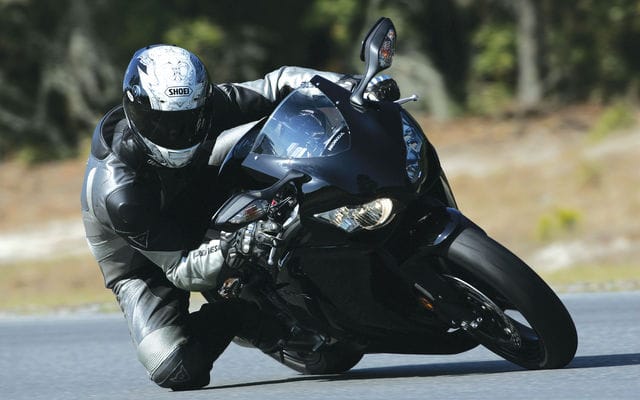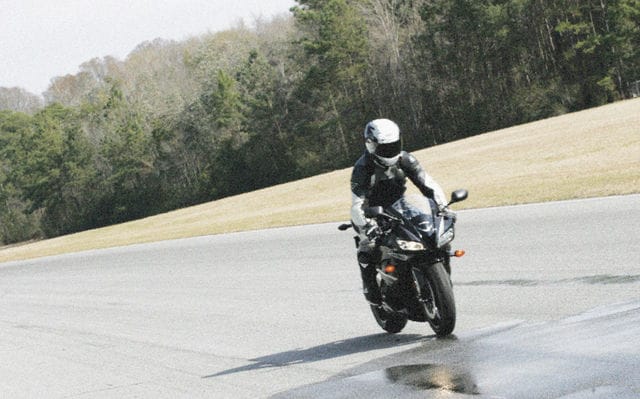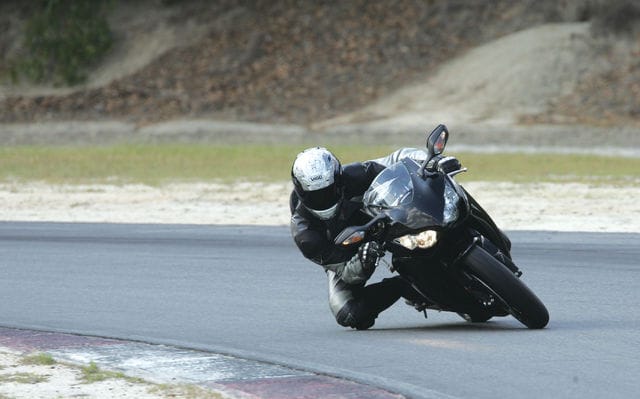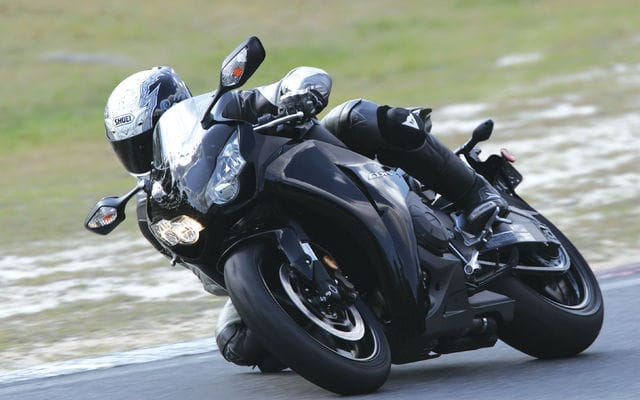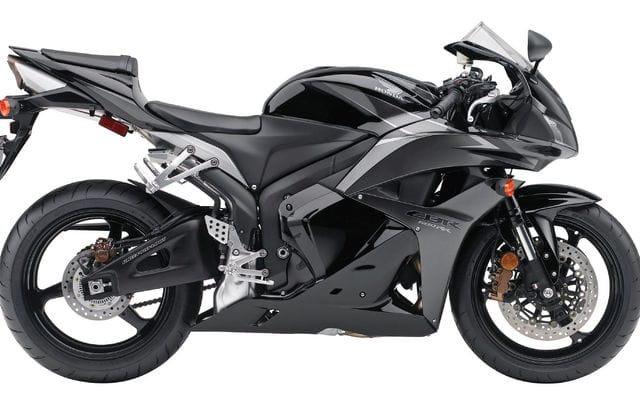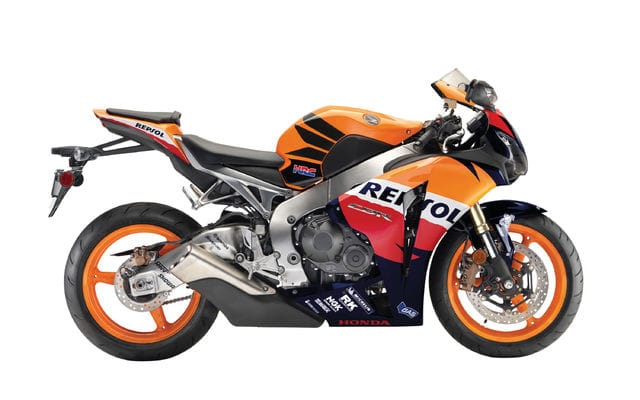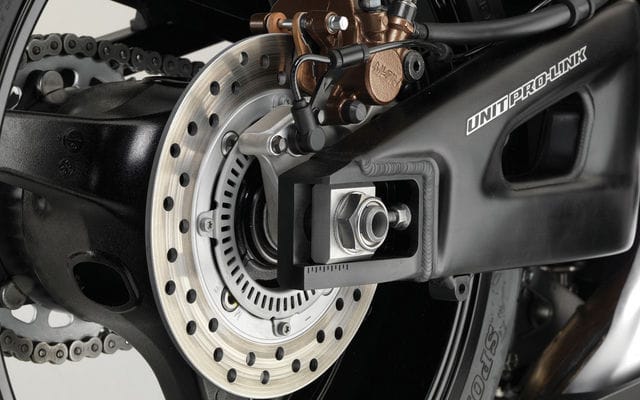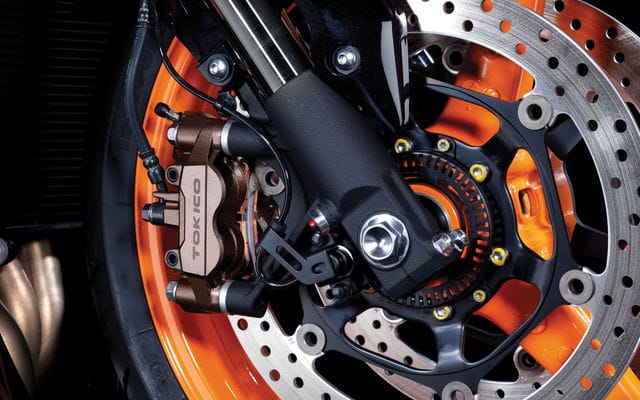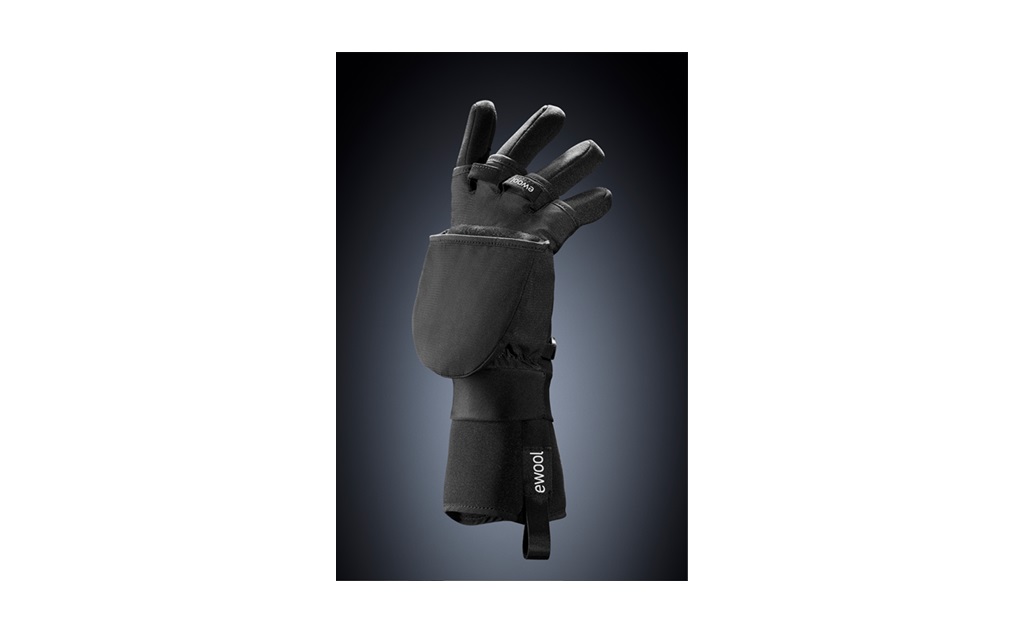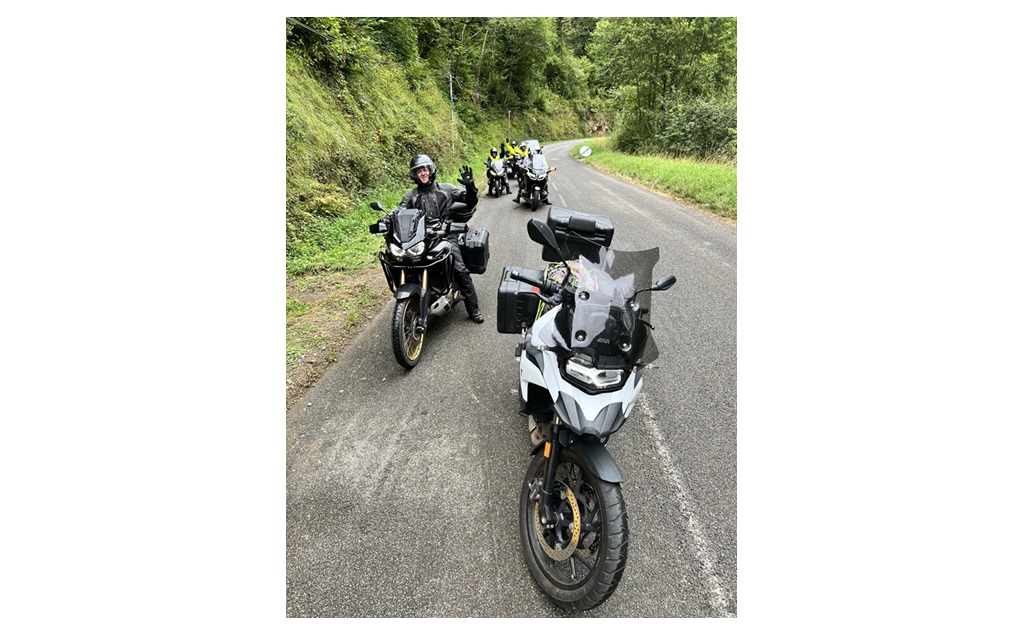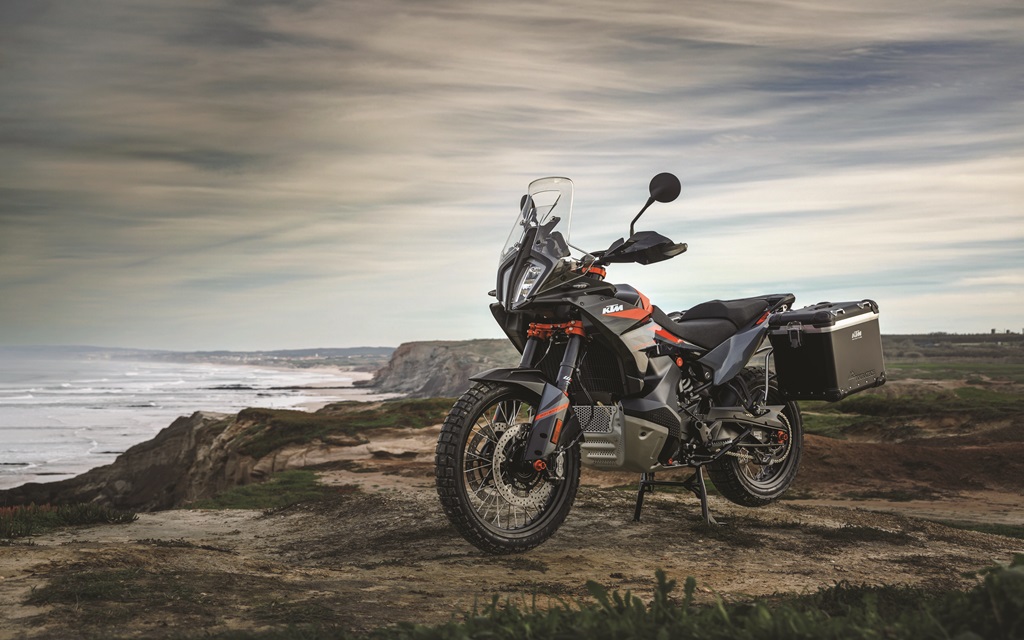Honda sets the motorcycle world on its ear by introducing anti-lock brakes to the sportbike set for the first time.
Trust. It’s the hardest thing to do. To trust someone, or something, is to take the hard-earned experiences of life and then to suspend that knowledge. I’ve trusted women, friends, employers and my own judgment. Upon close review most have faired well—except my judgment. My judgment with motorcycles is particularly poor. As a racer I nearly always made the wrong decision. Sometimes just showing up at the track was the wrong decision. So I’m having a hard time believing what Honda is telling me. Honda people (from the safety of the edge of the track, of course, which makes me even more suspicious—if I go down on my ass I’m going alone) are saying that I can reach 100 km/h and then squeeze the front brake as hard and as insensitively as I like. They’re telling me that I’ll be fine, that I won’t fall down and ruin another pair of leathers and mangle another helmet. And one more thing— the track will have water dumped on it, and not all over, but in one spot.
Of course the Honda has ABS, but what is unusual about it is that the CBR600RR and CBR1000RR are the first true supersports so equipped. (BMW’s HP2 Sport has ABS, but it’s not a supersort in the purest sense.) While fitting the ABS of a public-roads-only machine to a sportbike may seem like a straightforward case of simply transferring the technology from one machine to another, the demands of a sportbike mean that an entirely different system had to be developed. Why is this? Conventional ABS, where the lever pulses noticeably at the point of lockup, is fine for keeping your front fender out of a moose’s hindquarters, but on a razorsharp supersport its invasive nature discourages fine control. It would be like fitting a whammy bar to a Stradivarius— possible, of course, but of questionable benefit. Ferocious braking to the edge of traction is the final frontier for motorcyclists.
I used to think that leaning a motorcycle Photos: Rob O’Brien Anti-lock Action Honda sets the motorcycle world on its ear by introducing anti-lock brakes to the sportbike set for the first time. By Neil Graham »»PRESS LAUNCH HONDA CBR600RR & CBR1000RR ABS 40 CYCLE over until your knee and nearly your elbow skimmed the ground was a considerable feat, but it’s not so. While I am a respectably rapid track rider I am far from the pace of a serious racer, and yet in photographs I lean a motorcycle so far over that I look like I’m flirting with disaster, but I’m not—at least not until I chase someone. But braking is different. Truly hard braking is terrifying. The problem with learning how to brake hard on a motorcycle is the ramification of getting it wrong. A locked wheel can cause an intimate encounter with the pavement and the destruction of your pride and joy. And that’s assuming that you fall off in a place where you’re not run over by another vehicle. But ABS of any stripe—and particularly the super-smooth system on the CBR—is a potential lifesaver as well as a fabulous learning tool.
After all, how can you brake to the limit if you don’t know what the limit is? And that scenario described at the beginning of this piece— braking hard through a patch of water? Nothing to it; you couldn’t tell that any water was on the track. Roebling Road Raceway, just outside of Savannah, Georgia, was the location for Honda’s launch, and despite dire warnings from those in attendance who had been there before (bumps! holes! concrete!) the track was lovely, with enough tight corners to allow you to experiment with ABS—at least in theory. Looking over my shoulder to make sure that I was alone (and that Silver Fox Colin Fraser was not over his head trying to maintain my pace), I took in a big gulp of air and squeezed the front brake lever as hard as I could. The weight shift forward was dramatic— but even more dramatic was how quickly I slowed. “So that’s how hard you can brake,” I muttered inside my helmet before setting off to stuff Uwe Wachtendorf at the next corner (he took it good naturedly, though he may have a vicious payback planned for this summer).
But just as I had learned while riding Ducati’s traction-controlled 1198S, electronic intervention can begin a complicated relationship for a rider. With the Ducati, unsurprisingly, great dollops of throttle vault you forward with shocking rapidity. Which is fine until you realize that you have to stay on the track and out of the gravel pit at the next corner. The lesson is that both the Ducati’s traction control and the Honda’s ABS only intervene when you’re at the absolute limit. First, you have to reach the limit. Traction control can be viewed as a safety aid, but ABS easily trumps its usefulness as a lifesaver. A tire slipping on the exit of a damp corner can certainly lead to catastrophic results, but a prudent rider confronted with limited traction usually adjusts riding style accordingly. On the other hand, the animal that presents itself at dusk on a wet road does so without concern for prevailing traction conditions. On the street, then, advantage goes to ABS. On the track, the two aids rank much more closely.
On a track with good pavement and with modern, sticky tires, to brake late enough to trigger ABS means that you’re moving at a frightfully rapid pace—it’s one thing to jam on the brakes halfway down a lonely straightaway to test the system and quite another thing to have the confidence to wait until you can see the blackbird sitting in its nest in the tree at the end of the straightaway before braking. On only one of Roebling Road’s corners did I consistently brake hard enough for the ABS to intervene—but even then the system was impossible to detect through the brake lever. The only way I knew that ABS was protecting my interests was from experience. In a race a few years ago at the Mont Tremblant circuit north of Montreal, I had been, to my delight, lofting the rear wheel »»PRESS LAUNCH HONDA CBR600RR & CBR1000RR ABS under braking for a tight turn that preceded the front straightaway.
Like most sweet things in life it was good while it lasted, but too firm a grip on the brake lever eventually caused the rear wheel to rise off the tarmac and catapult me into the gravel safety trap. It hurt physically and financially (the bike, alas, had been borrowed, and was tweaked in the same ways that I was, but my chiropractic bills were ultimately less than the cost of replacement parts). But back to that corner at Roebling Road. My late braking point and the viciousness with which I squeezed the brake lever would have certainly caused the rear wheel to loft on a bike without ABS. And though I couldn’t confirm it at the time, I had my suspicions that the rear wheel was coming off the track slightly. Later, when other riders tested the system, the rear wheel indeed came off the ground, though only a few inches, and never at the expense of control. Regardless of its innovative braking system, there is still the rest of the motorcycle to discuss. New on the 2009 CBR600RR are monoblock brake calipers sourced from the CBR1000RR, in addition to new pistons, cylinder head, and an exhaust system that now has a power valve.
Having spent time last winter on the CBR600RR at the gnarly Streets of Willow Springs racetrack in California, I knew its charms well. And at Roebling Road, with its superior pavement and flowing layout, the 600 was a gem, but it was the CBR1000RR that really shocked. In the March 2008 issue of the magazine, Costa Mouzouris reported from the Qatar launch of the then-new CBR1000RR that Honda had promised magazine hacks a “deep soul experience,” but his misplaced luggage and too-small borrowed riding boots had instead given him a sore sole experience. Motorcycle launches, especially sport bike launches, where product differentiation amongst the Japanese Big Four is very slim, pummel testers with improbable acronyms and ever more hyperbolic phrases. But ignoring the “deep soul experience” (the closest I’ve been to that is listening to Otis Redding) and concentrating on the motorcycle shows that Honda has been just as busy in the workshop as it has been in the copywriting department.
Honda marches to its own drummer with product development, and does not adhere to the savage cycles of model replacement that preoccupy the other Japanese brands. While this means that Honda occasionally lags behind its foes, it also means that when a new bike comes along there is usually much that has changed. That was certainly the case with the 2008 CBR1000RR. Gone was the most accommodating, silky smooth and sophisticated of the Japanese 1000s, replaced by a cutting edge sportbike much closer in vision to the competition’s machines. Though the bike’s dimensions do not greatly differ from the machine that it replaced (key measurements are similar and weight is only 4 kg less) the result, courtesy dramatic weight redistribution and a much stiffer chassis, is dramatic. Gone is the softness of the old bike (and had we ridden on the street it would have been sorely missed) and in its place is a tight, taught road burner.
Steering effort is very light and flicking from one side to the other in turning transitions is effortless. Thankfully the rheostat-smooth throttle response of the old bike remains, which makes the 1000 a revelatory experience— it is the first time that I have ever preferred a 1000 to a 600 when I’ve had the chance to sample both simultaneously. It may not sound like so dramatic a claim but while I’ve always admired (or, more truthfully, been terrified of) the massive grunt of 1000s, I’ve always gone faster and had more fun on 600s.
But the CBR1000RR narrows the gap between 1000s and 600s with its nimble handling and predictable power. Honda, by introducing ABS to sportbikes, follows through on its safety mantra with an exceptionally well-engineered system. But that was no surprise—that’s what Honda does. For 2009 the CBR600RR comes with ($13,999) or without ($12,999) ABS, while the ABS-equipped $16,599 CBR1000RR is your only option in the big bike. But more startling that the engineering is Honda’s refocusing on truly sporting machinery. We’ve said it in these pages before but it’s worth noting again: Honda was at risk of becoming the General Motors of motorcycling. But those who have grown up riding Hondas will be pleased to see continued signs of life from Big Red.
Brake as hard as you like
Honda’s new system is essentially brake-by-wire. There is no direct connection between brake pedal or lever and brake caliper. The pulsing felt through the brake lever on a conventional ABS system is the bleed valve releasing pressure so that the wheel doesn’t lock. While it is an indicator that the system is working, the pulsing sensation can be disconcerting, especially if you’re attempting to accurately maintain strong braking. Honda’s system—isolating rider input from the braking process— allows the motorcycle’s sophisticated electronics to provide lever feedback that is not influenced by machine braking. This may sound counterintuitive, but in practice it’s anything but. If you’re braking on damp pavement going into one of Mosport’s concrete-riddled corners (choose a corner; any corner) the last thing you need when you’re trying to scrub off speed is a twitching and dancing brake lever.
This is how it works: hydraulic pressure generated at the front or rear brake lever does not go directly to the caliper, but is detected by a sensor, which then directs the ECU to apply sufficient brake pad pressure through a parallel system. The lever feels the same as on a conventional brake system (indeed, when switching between non- ABS and ABS CBR600s it was necessary to check the front wheel for the sensor ring—lest you pile on the brakes savagely on the nonequipped bike). Pressure at the lever is essentially manufactured by the system; no pulsing is felt because excess pressure is bled by the parallel system—down where the braking occurs.
